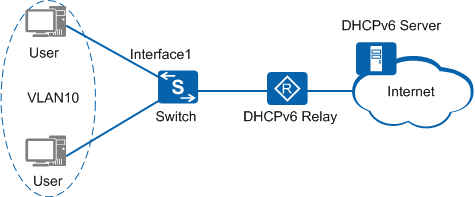Detecting Client Locations Through an LDRA
An LDRA-enabled device can record client location information and forward the information to the DHCPv6 server. The DHCPv6 server then assigns IP addresses, accounting policies, and access control policies to the clients based on the client location information.
In Figure 1, users obtain IPv6 addresses through DHCPv6. The administrator wants to restrict the network access rights of the users on interface1 to improve network security.
In the traditional process of allocating IPv6 addresses, the DHCPv6 server cannot obtain the physical locations of clients. Therefore, the server cannot assign specified IP addresses or policies to users on a certain interface.
To solve this issue, the administrator enables DHCP snooping and LDRA on the Switch. The Switch can then obtain the location information of clients and forward the information to the DHCPv6 server. The server assigns IP addresses and security policies to clients based on the client location information.
The LDRA function records only the client location information and forwards the information to the DHCPv6 server through Relay-Forward messages. The differentiated policies for IP address allocation, accounting, and access control are configured on the DHCPv6 server.
